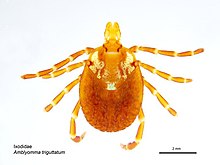Amblyomma triguttatum
| Amblyomma triguttatum | |
|---|---|
 | |
| Amblyomma triguttatum female | |
| Scientific classification | |
| Domain: | Eukaryota |
| Kingdom: | Animalia |
| Phylum: | Arthropoda |
| Subphylum: | Chelicerata |
| Class: | Arachnida |
| Order: | Ixodida |
| Family: | Ixodidae |
| Genus: | Amblyomma |
| Species: | A. triguttatum |
| Binomial name | |
| Amblyomma triguttatum Koch, 1844 | |
Amblyomma triguttatum, commonly known as the kangaroo tick, is a species of tick in the genus Amblyomma native to Australia, in Western Australia, parts of Queensland, and in New South Wales.
Subspecies[edit]
There are four subspecies, one or more of which might be separate species.[1] The nominate subspecies is a vector for Rickettsia.[2]
Ecology[edit]
Like all species in its family, Ixodidae (known as hard ticks), the kangaroo tick is a parasitic arachnid and is an obligate hematophage, solely consuming blood for its nutritional needs.[3]
Hosts[edit]
Thought to be a carrier of Q fever, in addition to parasitising macropods such as western grey kangaroos and Tammar wallabies, it has been found on a variety of other mammalian hosts, including black rats, European rabbits, domesticated dogs and cats, and humans.[4]
References[edit]
- ^ Alberto A. Guglielmone; Richard G. Robbins; Dmitry A. Apanaskevich; Trevor N. Petney; Agustín Estrada-Peña; Ivan G. Horak (2013). The Hard Ticks of the World: (Acari: Ixodida: Ixodidae). Springer Science & Business Media. pp. 510–11. ISBN 9789400774971.
- ^ Li AY, Adams PJ, Abdad MY, Fenwick SG (2010). "High prevalence of Rickettsia gravesii sp. nov. in Amblyomma triguttatum collected from feral pigs". Vet. Microbiol. (Submitted manuscript). 146 (1–2): 59–62. doi:10.1016/j.vetmic.2010.04.018. PMID 20488632.
- ^ "Life cycle of Hard Ticks that Spread Disease". Centers for Disease Control and Prevention. Retrieved 19 December 2020.
- ^ Waudby, Helen P.; Petit, Sophie; Dixon, Bruce; Andrews, Ross H. (5 July 2007). "Hosts of the exotic ornate kangaroo tick, Amblyomma triguttatum triguttatum Koch, on southern Yorke Peninsula, South Australia". Parasitology Research. Vol. 101. pp. 1323–1330. doi:10.1007/s00436-007-0642-4. PMID 17611781.


 French
French Deutsch
Deutsch